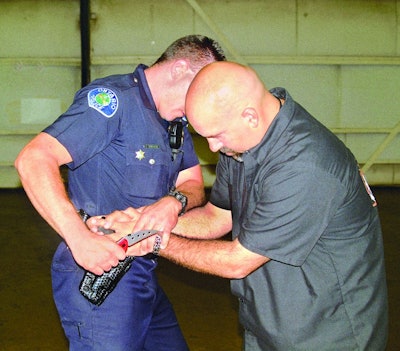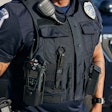 Knives are great tools, but can also be used as weapons of last resort.Photo: Paul Pawela
Knives are great tools, but can also be used as weapons of last resort.Photo: Paul Pawela
Few law enforcement agencies issue knives to their officers, but many would consider this tool to be essential on duty. So most officers must purchase a knife on their own. Knowing how to find the best kind can be daunting, but taking into consideration how you'll be using a knife and how much you can spend on it makes the process easier. Here's a look at what officers tend to seek out in knives depending on their needs and preferences.
What Officers Think They Need
Newer officers tend to focus on durability and ruggedness, which probably aren't the best determinants of a useful duty knife. Durability is important, but maybe not in the way novice knife owners might think.
Michael Janich is the founder and lead instructor of Martial Blade Concepts, which focuses on knife training. He says officers unfamiliar with knives tend to think they should be thick and heavy to withstand hard use so they often choose something that is not the best cutting tool. Also, officers who are intensely budget conscious and unfamiliar with differences in knife quality tend to opt for the cheapest models. But you get what you pay for.
"Over time, they realize they need a better cutting tool, and that investing in quality tools is important," Janich says. "Just like investing in a good off-duty holster is a good idea, and investing in a quality belt to support that holster is a good idea."
More money will buy you a better quality knife. "The execution of the knife, the design, the engineering, and the blade steel are all going to be of higher quality," says Janich. That means it will last longer, be easier to use, and it will cut everything better. That doesn't mean you should break the bank on a specialty custom knife, unless you want to. A moderately priced model made of quality materials should do the job when you need to cut open a box or most other things you'll come across.
Blades
Officers who aren't knife enthusiasts and know they don't want to spend a lot of time on upkeep usually choose a knife with a blade that's easy to maintain. This means a serrated or partially serrated edge because it will stay sharper longer. Serrations also offer a sharper edge for cutting fibrous materials like seat belts.
As for the shape of the blade, officers who have trained with a certain blade shape they're comfortable with will continue to buy that type of knife. But for most, the decision on blade shapes usually comes down to the difficulty in sharpening them.
"The tanto is everybody's favorite, but most guys don't understand they need to be careful when they sharpen them to maintain blade symmetry," warns Rob Cabrera, director of the blade division at DoubleStar Corp. "My favorites are spear points: they're easy to sharpen and have great piercing attributes. They're not very good for prying, but knives are not meant for prying," he says.
A drop-point is another blade shape popular with law enforcement officers. It has a straight spine and a curved, smooth arc on the cutting edge to create what Cabrera calls "a regular belly, like what your grandpa used." It's easy to sharpen and has attributes similar to those of the spear point blade.
Another consideration is blade steel. "The most popular knife designs out there these days are made with stainless steel because they're corrosive resistant and are going to require a minimum of maintenance to keep them in good working order," says Janich. The quality of stainless steel has improved, making it easier and more affordable to obtain a knife made with good quality stainless steel suitable for patrol, even if you aren't super knowledgeable about the distinctions between different types. A full steel blade will hold an edge longer, but it's more difficult to maintain.
Handles
Holding the handle of a knife should feel right, whatever that is for you. The ergonomics will be different for everyone, so it's worth holding and manipulating a knife as you would on duty to find the best fit. Officers also want something that fits easily on their duty belt, clipped to their pocket, or someplace conveniently accessible. Again, this comes down to preference.
What everyone can agree on is needing a handle that provides a good grip, even with wet or gloved hands. Cabrera prefers a very rough checkering for this purpose. He says you should be able to feel it even through gloves. This will ensure that it's not going to slip out of your hand.
Knife handle materials vary widely, and include plastic, stainless steel, and titanium. Wooden knife handles absorb moisture so they can shrink or crack when they become wet, so most officers stay away from them, at least for duty.
Opening Mechanisms
It's important that a knife deploy and stay open reliably. You can test the lock of a knife by hitting the spine of the blade against a hard surface a few times to determine how well the lock holds.
Most officers carry folding knives, which are made with various types of locks. "Now the flavors are liner locks or frame locks," says Cabrera. He prefers liner locks, which use a side-spring lock and can easily be opened and closed with one hand. He notes that some people like frame locks because they come in fancy aluminum or titanium to dress them up. Frame locks are very similar to liner locks, but a frame lock uses the handle to form the frame and therefore the lock. Some officers want "flippers," which are folding knives with a thumb stud that can be used to manually open them quickly.
Other officers prefer automatic knives because they can be deployed so rapidly. Many states prohibit the use of automatic knives, but often provide exceptions for law enforcement officers. Janich warns that a double-action, out-the-front automatic knife is to be avoided because if something sticky like tape residue gets stuck on the blade, when the blade retracts inside the knife it will get stuck and "gum up the action" so it won't deploy when you need it most.
Utilitarian Use
To best decide what knife to use, you need to know how you'll be using it. If you're just looking for something to cut well and withstand hard use, a utilitarian knife will do the job. If you must use a knife tas a prying tool, use one that is sturdy. The trade-off is what you gain in robustness you'll probably lose in cutting efficiency.
One officer Janich knows almost exclusively used knives as prying tools while he was a SWAT officer for "light breaching." But when he switched to working narcotics, he found he needed a knife that actually worked as a cutting tool to slice open bags and other drug packaging. He ended up replacing all the knives he'd used on duty in the past.
Uniformed officers often use knives as rescue tools for accidents and medical emergencies. For these purposes, a carbide tip for breaking windows is popular. It can be used to get an injured person out of a crashed car as well as to remove an offender from a vehicle. A blade that can make easy work of the fibrous material of a seat belt is also important for rescue work. Officers who want a knife specifically for rescues often prefer a blunt sheepfoot blade to safely cut and remove seat belts or clothing from people without cutting the wearers.
It's common for officers to carry several different knives, and possibly a multi-tool, to serve different purposes. "There really is no one-trick pony for [law enforcement work]," Cabrera says.
A Knife as a Weapon
Carrying a knife for use as a weapon on duty can be a tricky subject. Many agencies don't allow officers to carry knives on duty for use as deadly force weapons. And they may or may not provide training for defensive tactics using knives depending on their policies.
"From a utilitarian point of view, a folding knife has a little bit more clout, if they want to write it into their protocols without it seeming too ominous," says Cabrera. "Most municipalities are looking at what looks good to the public." However, as far as what works best to fight and survive, Cabrera recommends a fixed blade for use as a weapon. It's easily deployed and not prone to breaking because of its simple, solid construction.
Undercover officers often can't carry handguns with them so they prefer folding knives for use as a weapon if needed. Many people carry them, not just police officers, so it shouldn't throw up any red flags.
As Janich observes, many officers purchase a knife with the intention of using it to prevent a gun grab. But most don't train to effectively use it in that capacity. "They'll look for a knife that they can carry comfortably on their lefthand side simply because they think that's what they should be doing, whether they have the skills to back it up or not," Janich says. Instead, he advises purchasing a knife for what you'll really use it for.
With that said, there are officers who have successfully used their knives to save their lives in deadly confrontations. An officer who was handcuffing a suspect had only gotten one cuff on him when the suspect swung his hand and hit the officer with the handcuffs. "The guy went after his gun, and the officer drew his knife and used it to kill the suspect," Janich shares.
For this reason, Janich wants to remind officers that whichever knife you choose to carry, it's imperative to always train the way you're going to use it.
Keeping it Simple
Officers prefer different knives based on their assignment, training, and agency policies, but most are looking to meet the same needs. "In my experience, officers like small, discreet knives; something that's going to quickly attach to their duty belt and not attract any attention," says Cabrera. Beyond that, it's a matter of finding the best fit for individual circumstances. "Look for the best quality they can reasonably afford, and make the most educated choice they can," advises Janich.

















